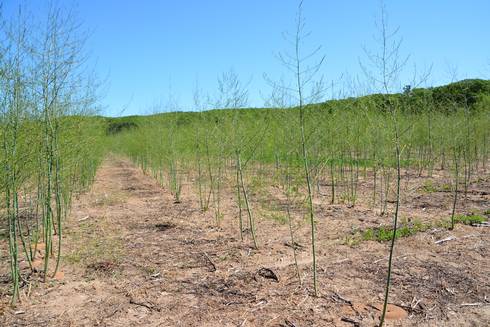Jun 13, 2018Watch the timing for postharvest weed control in asparagus
Asparagus harvest is reaching completion in many parts of Michigan. Most growers harvest fields 20-25 times during a typical season. Harvest this year started slowly with cool weather in late April and early May, then increased rapidly with unseasonably warm weather for the last two weeks of May. This resulted in daily harvests of fields, and most fields have been picked about 20 times by now. There is a very short window between final harvest and fern growth for applying post-emergence herbicides to control perennial and annual weeds. A residual herbicide for weed control through summer also should be applied at this time.
Asparagus growers have several choices of herbicides for controlling emerged weeds. The synthetic auxin herbicides 2,4-D (Formula 40) and dicamba (Clarity) are effective against many broadleaf annuals and perennials. They also can injure asparagus plants if there is too much contact with spears or fern. They should be applied within one day of the final harvest in a field.
Clopyralid (Spur) and quinclorac (Quinstar) may also be applied after harvest. Clopyralid is effective against the weeds in the Asteraceae, Fabaceae, Solanaceae, Polygonaceae and Plantaginaceae families. Quinclorac is effective against bindweed, Canada thistle, sowthistle, Russian thistle and ragweeds.
Glyphosate (Roundup) may be applied immediately after a complete harvest. A combination of glyphosate plus one of the synthetic auxins often improves controlling difficult perennials. Check the labels of the various herbicides for instructions on tank mixes.
If applying post-emergence herbicides other than glyphosate, it normally is efficient to include a graminicide (Fusilade, Poast, SelectMax) in the mix. That will kill emerged annual grasses and stunt or set back perennial grasses.
Residual herbicides should also be applied after final harvest for the year. Using two herbicides with different modes of action has been the most effective method for long-term and complete control of most weeds. The post-harvest herbicides generally should be different from those applied pre-emergence in the same year.
If some asparagus has already gone to fern in some fields and there is serious weed presence, it may be effective to mow the field at 6-8 inches above the soil to leave sufficient weed biomass to receive the post-emergence herbicides and also remove most of the asparagus fern to avoid crop injury. The stalks left in the field normally do not take in sufficient herbicide to cause permanent crop injury.
Herbicide recommendations can be found in “Weed Control Guide for Vegetable Crops,” Michigan State University Extension bulletin E433. Herbicide labels can be found online at Crop Data Management Systems (CDMS).
– Bernard Zandstra, Michigan State University















